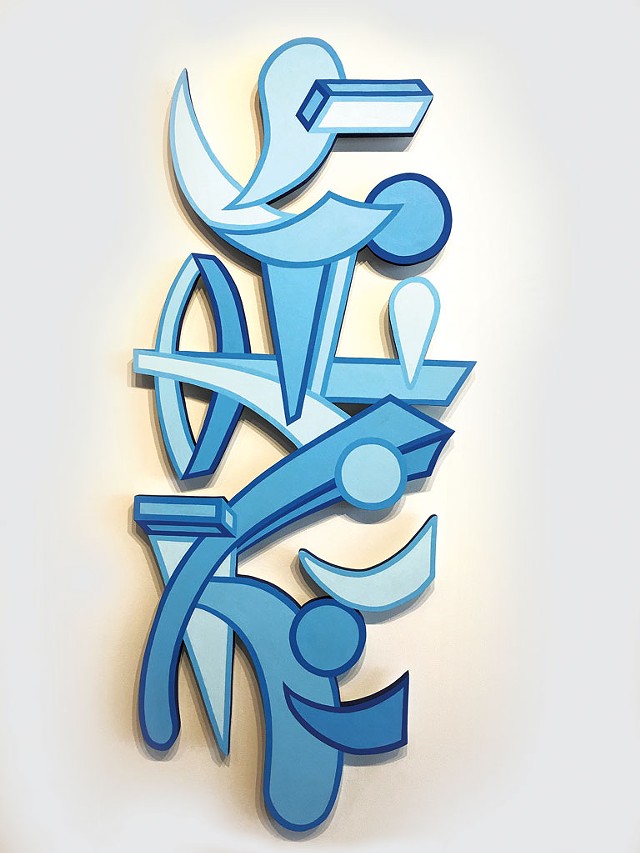
- Courtesy
- "toss-up" by Will Gebhard
At the Phoenix, a gallery and music hall in Waterbury, the graphic quality of the current exhibition suits the sleek new venue. Each of the five exhibiting artists plays with line, form and color in ways that substantiate the first sentence of Joseph Pensak's curator statement: "Art is candy for the child within us." (The sentiment is abetted by the presence of an actual small candy shop in the gallery.)
Not that the art is childlike. If play is evident in the artworks of Athena Petra Tasiopoulos, Will Gebhard, Steve Budington, Will Patlove and Frank Tamasi, so are sophistication and distinctive vision.
Three of the artists roguishly reject the standard rectangle. Patlove does so with wood cutouts and shaped canvas, and his inventive manipulations of geometry and perspective dominate this exhibition. The 17-by-12-inch piece "Center Pivot" — which inspired the gallery's logo — began as a square of wood painted a vivid marigold yellow. On it Patlove painted the orange outline of a parallelogram, whose top left and right bottom angles extend beyond the square in thin wood pieces.
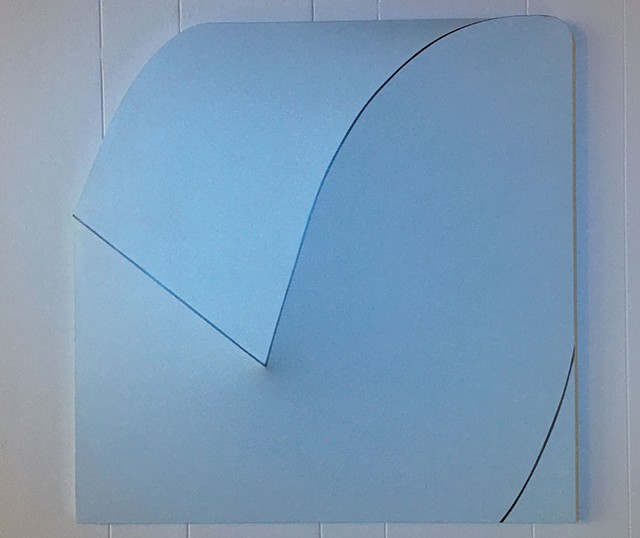
- Courtesy
- "Smyrna" by Will Patlove
Patlove also uses his construction skills to create shaped-canvas works. "Smyrna" is a 37.5-inch near-square; the top left corner is rounded off. That arc mirrors the three-dimensional surface created by stretching canvas over an underlying structure. Where the canvas gently protrudes, Patlove painted a contrasting line to emphasize its curviness. Light and shadow collude in fooling our eye.
Gebhard is known for rendering brightly colored, squiggly geometric compositions on paintings, murals, sculptures and products, including beer can labels. For the Phoenix exhibit, he contributed a wall-hung sculptural work, "toss-up," that is a marvel of precision. A cascade of geometric and indefinable cutout shapes is painted in several shades of blue — including lines that signify volume. Though not quite reminiscent of M.C. Escher, the shapes overlap and interrelate in ways that confound the eye. Gebhard's remarkable construction seems to hover against the white wall like an inexplicable life form.
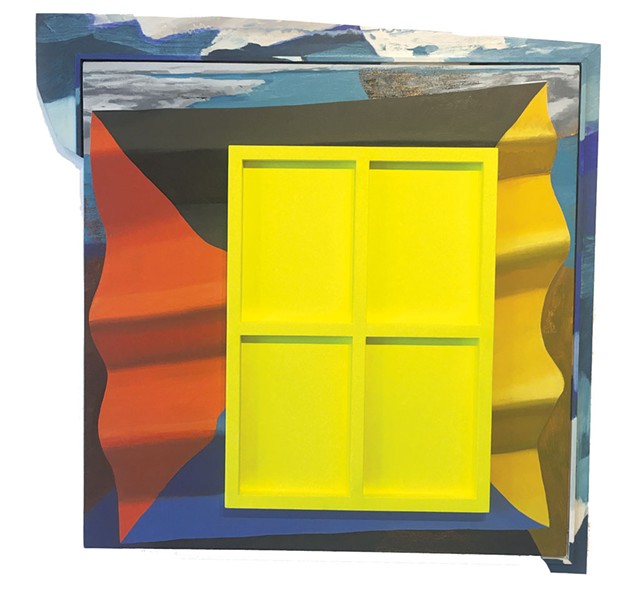
- Courtesy
- "Call Shore" by Steve Budington
Budington's singular work defies categorization. Sculptural paintings? Painted sculptures? Each of his three wall-hung pieces in "Art Is Candy" is an assemblage of seemingly disparate parts, as if he had deconstructed other works and recombined them into new ones. "Call Shore," for instance, begins with a 33-inch-square canvas painted with what resembles a smaller, corrugated square in red, yellow, black and blue floating against a sky-like background. Attached to the center of the canvas is a bright-yellow rectangular wood "window" divided into four panes. Budington attached wooden strips, painted in blues and white, along two sides of the canvas.
His own straightforward description of this work belies its complexity: "oil and fluorescent acrylic on canvas over wood panels, partial frame."
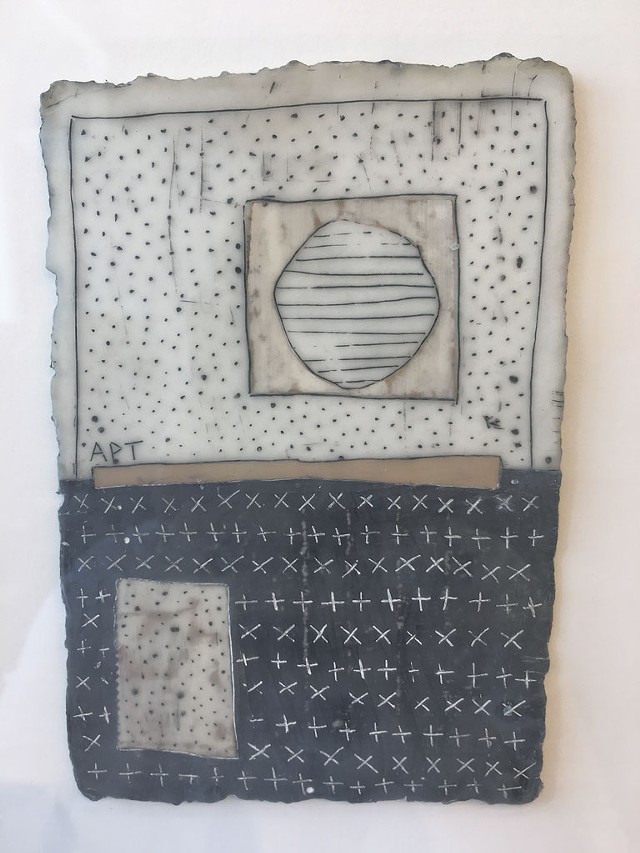
- Courtesy
- "Where We Came From" by Athena Petra Tasiopoulos
Tasiopoulos goes for quieter compositions. Her five small pieces — encaustic and mixed media on paper — are meditations on geometric forms with fields of mark making and a limited palette of black, whites and brick red. "Where We Come From," just six inches high, is divided nearly equally into a black bottom and off-white top with X marks, plus signs, dots, and square and round patches. The artist's hand is evident; lines are not perfectly straight, and some of the marks resemble stitching. The paper itself has a handmade look, with uneven edges. Tasiopoulos gives us a softer, gentler geometry with works suggestive of tiny quilts.
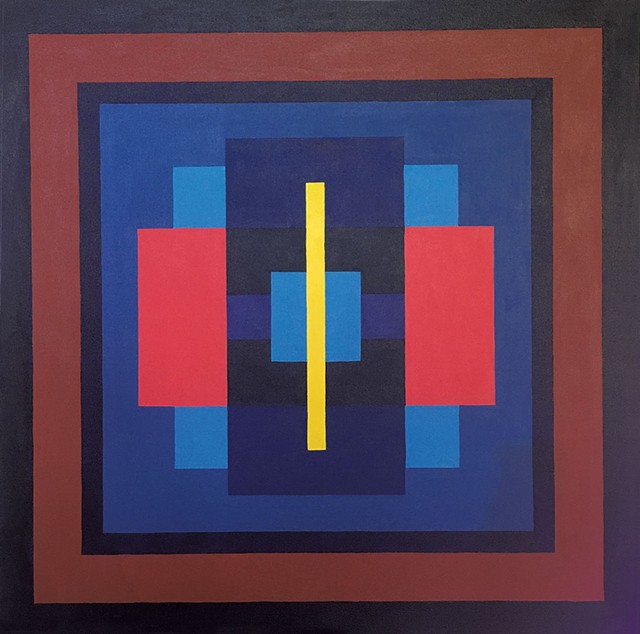
- Courtesy
- "Unity #1" by Frank Tamasi
Tamasi, in contrast, remains faithful to right angles. His acrylic works on canvas are exacting arrangements of rectilinear shapes and saturated color. In his 36-inch-square "Unity #1," a central yellow strip provides a visual fulcrum for mirror images of tomato-red, sky-blue and black overlapping rectangles. The aptly named "Trance" is a 24-inch-square canvas composed of four squares with a fifth square of equal size superimposed in the center. Each is painted in precise lines of lighter and darker blues over black, alternately pushing and pulling the eye. Tamasi's tightly constructed canvases employ both logic and color theory to activate some optical magic.









Comments
Comments are closed.
From 2014-2020, Seven Days allowed readers to comment on all stories posted on our website. While we've appreciated the suggestions and insights, right now Seven Days is prioritizing our core mission — producing high-quality, responsible local journalism — over moderating online debates between readers.
To criticize, correct or praise our reporting, please send us a letter to the editor or send us a tip. We’ll check it out and report the results.
Online comments may return when we have better tech tools for managing them. Thanks for reading.